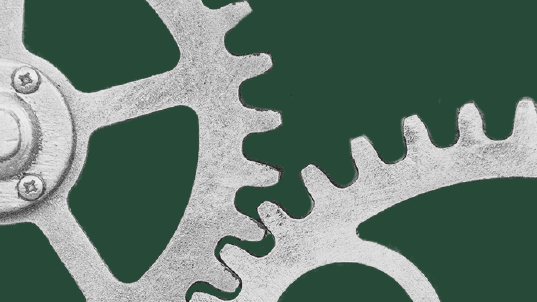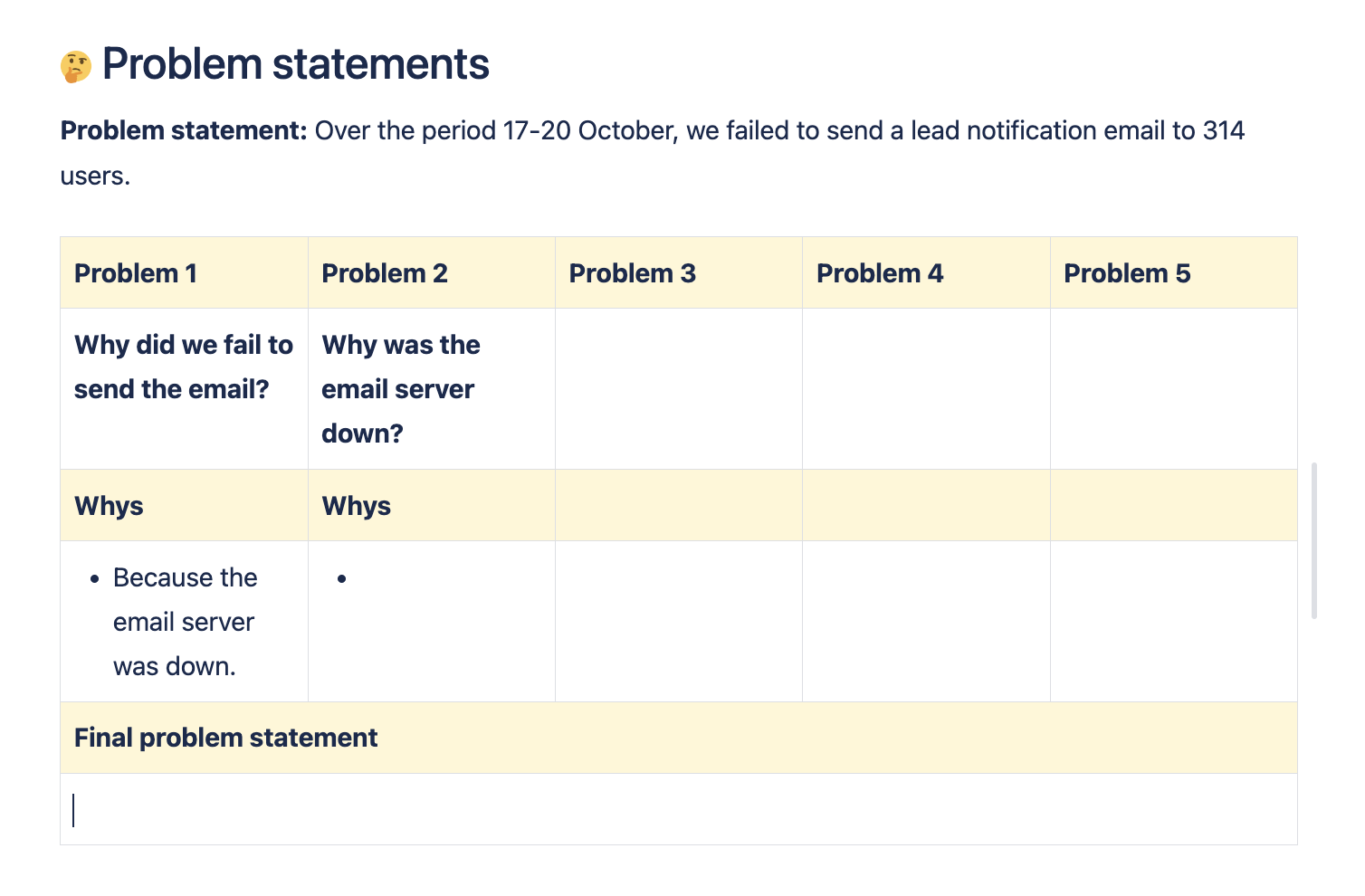五大原因分析
如果一个项目在团队的努力下仍未达到预期目标,请花点时间找出根本原因。五问法分析演练可以帮助您的团队多次询问“为什么”,直到发现核心问题。

准备时间
5 分钟
持续时间
30 分钟
人数
3 - 8
5 秒摘要
- 选择一个问题陈述。
- 询问五次“为什么”以确定根本原因。
- 建议解决方案。
您将需要
- 带屏幕共享功能的视频会议或会议空间。
- 数字协作工具(参见模板)。
- 可选:实物白板、记号笔和计时器。
演练资源
如何进行五问法分析
帮助您的团队找到问题的根源—无论是事后分析,还是探索新机会。
什么是五问法分析?
五问法分析是一种解决问题的技巧,包括询问五次“为什么?”,以揭示问题的根本原因。
为什么要开展五问法分析演练?
了解如何将当前或过去的问题转化为解决方案。五问法分析有助于找出项目未能达到预期的原因。您将指导团队通过一个流程找出具体问题,并逐步缩小问题范围,直至找到令人满意的解决方案。
什么时候应该进行五问法分析?
五问法分析几乎适用于任何问题、团队或行业。Atlassian 团队会在项目未按计划进行时使用这种技术,他们希望找出根本原因,防止问题再次发生。
五问法分析的 5 个好处
- 确定根本原因,而非症状:通过反复询问“为什么”,该分析有助于更深入地了解问题,从而揭示问题的根本原因,而不仅仅是解决症状。
- 提高解决问题的技能:这一过程可以训练个人进行批判性思维和质疑假设。
- 预防将来出现问题:通过解决根本原因而不是临时修复,五问法分析有助于减少类似问题的再次发生。
- 促进持续改进:五问法分析可以培养一种寻求更好方法解决问题的文化。
- 促进团队协作:让多名团队成员参与五问法分析,可以促进不同观点的碰撞,产生更丰富的洞察信息,并加强团队的一致性。
1. 确定您的问题
预估时间: 5 分钟
准备一份问题陈述。可以是团队目前面临的问题,也可以是过去发生的需要解决的问题。
对于远程团队,请创建一份协作文档(参见随附的可选模板),并提前与团队共享。对于面对面的团队,在白板上标注下面所示的栏目:
问题 1
问题 2
问题 3
问题 4
问题 5
我们如何解决这个问题?
3. 询问“为什么?”
预估时间: 5 分钟
对于最初的问题陈述,询问问题发生的原因。请团队考虑:
- 为什么会发生这种情况?
- 是什么造成了[问题]?
- 哪些决策导致了 [问题]?
- [问题]发生的条件是什么?
- 导致 [问题] 发生的次要因素是什么?
将计时器设置为五分钟。让您的团队独立工作,在协作文档或白板上添加他们自己的答案。作为一个团队,选择其中一个答案并记录下来。
提示:进行投票
对问题陈述进行投票以推进工作。试试 Trello Voting Power-Up 或者让团队在他们选择的陈述中加上 +1。
4. 确定下一个问题陈述
预估时间: 5 分钟
将回答转化为“第二个问题”。同样,设定一个五分钟的计时器,继续询问“为什么”并记录回答,直到团队找到问题的根本原因。
让团队将回答记录在协作文档或白板上。
5. 反复询问“为什么?”
预估时间: 20 分钟
重复第三步和第四步,直到总共问了五次“为什么?”。
提示:继续询问原因
可能需要询问少于或多于五次“为什么”才能找到根本原因
6. 确定根本原因
预估时间: 5 分钟
在询问五次“为什么”之后,记录团队所认为的问题根本原因。
接下来,通过研究解决这个根本原因是否能防止最初的问题再次发生,验证您的最终问题陈述。
提示:大胆点!
觉得应该大胆一点?何不请您的关键团队的领导者与他们的团队一起进行这个游戏?如果您发现了网络差距,可以从在团队中开展角色与职责游戏开始。
7. 建议解决方案
预估时间: 10 分钟
找到根本原因后,让团队成员针对您的最终问题陈述提出解决方案。只选择一两个解决方案,为每个解决方案指定负责人,并确定团队何时能收到负责人的回复。
跟进
分享
记录您在演练中的笔记,以便整个团队都能查阅。接下来,将问题陈述作为工作项添加到团队的工作面板(如 Jira 或 Trello),以跟踪进度。最后,确保在商定的时间检查建议的解决方案。
变体
分组
在第一步集思广益后,与其对一个问题陈述进行投票,不如将群组分成团队,每个团队负责一个问题陈述。然后按团队进行剧本的剩余部分,看看每支团队最终会得出什么根本原因。

还有问题?
与其他 Atlassian 使用手册用户开始对话、获取支持或提供反馈。
您可能喜欢的其他演练
协作
角色和职责
明确个人责任,找出需要填补的空白。
项目规划
团队网络
在项目开始时,规划并优化跨团队关系。
项目规划
项目启动
就目标、时机、范围和决策达成共识。
工作效率
工作协议
创建共享规范,帮助您的团队通力合作,实现共同的目标。
了解最新信息
注册我们的时事通讯,获取最新的演练和 工作生活建议。















